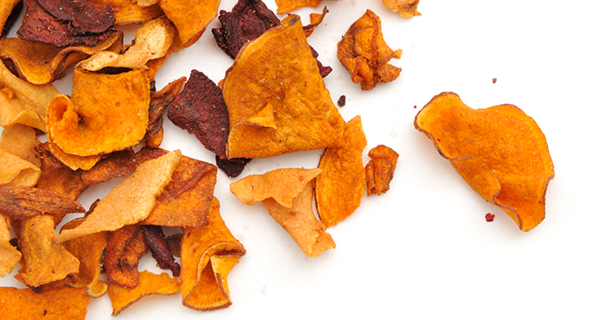
The food revolution led by a new generation of health-conscious consumers is deeply innovating the most popular and indulgent category: chips. A segment of the universe of snacks, chips now contain much more than just potatoes. Producers are experimenting with yellow and blue corn, lentil flour, and all sorts of fruits and vegetables to appeal consumers looking for vegetarian alternatives.
APPLE CRISPS – Potato chips have the largest share of the salty snacks category, with 21.9 billion dollar sales in the US in the 52 weeks ended April 17, 2016, according to IRI data reported by Snack and Bakery. But sales of crispy chips grew only 1.05% compared to the same period of 2015, outpaced by apple chips, whose sales soared by over 40% for the second consecutive year to 18.3 million dollars, according to the report. Companies are also seeking alternatives to potatoes, using from lentils to blue corn, and a more adventurous trend is now emerging: high-protein cricket chips, where whole crickets are milled into a fine flour.
SNACKIFICATION BLURS SWEET AND SAVORY – Energy bars, savory packs and semi-dried fruit have become a handy alternative to traditional meals for consumers always on the go. Squeezed between commuting, short lunch break, and a gym session, younger generations are eating less but more frequently.
GENERATION ON THE GO – According to a 2014 global survey by research firm Canadean, 19% of consumers aged 15-17 said they tend to snack outside mealtimes while traveling and commuting, compared to 11% of people aged 45-54 and 7% of over 65.
Salty snacks are a very popular choice. Chips pretzel and snacks contributed 29.3% to US snack sales of 920 million dollars in the 52 weeks ended June 17, according to research firm SPINS.
The salty snacks market is estimated to reach a global retail value of around 73 billion dollars in 2016, up from 62 billion in 2011, according to data by Euromonitor Passport released to ItalianFood.Net. In volume terms, the sector is estimated to have grown 19.7% in 2011.
On the sweet side, plain biscuits, cookies, chocolate coated, sandwich and filled biscuits represent a more traditional solution loved by children and indulgent adults. Wholegrain flour and natural fruit fillings are used for a healthier choice.
Global sales of sweet biscuits have risen to 62.634 billion dollars in 2016, up from 55.3 billion in 2011, while volumes have increased 13.9% in the period, according to Euromonitor Passport data.
FOODIE INNOVATION – The new “foodie” generation is putting pressure on food makers to innovate flavors and formats. As health-conscious consumers want “good” products, packed with energy, cereal bars are experimenting the strongest innovation. Traditionally mixed with dried fruit, these nutritional snacks are blurring the boundaries between sweet and savory.
SWEET AND SOUR – Inspired by the Mediterranean Diet, manufacturers are launching all-natural, gluten-free nutrition bars rich in fibers, nutrients and vitamins. In addition to sweet bars with apricot and pistachio or orange and honey, there are some that are launching line of savory bars with kale & pumpkin seeds, bell pepper and green olives, sun dried tomato and basil.
